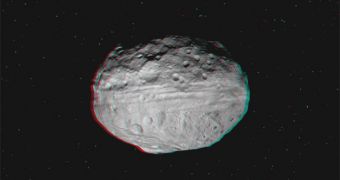Experts at the NASA Jet Propulsion Laboratory (JPL), in Pasadena, California, have just released a new video showing the largest asteroid in our solar system, Vesta, in 3D. The short clip was put together from data collected by the NASA Dawn mission, which is currently orbiting the space rock.
The spacecraft entered its first orbit around Vesta this July. The asteroid is located in the Inner Asteroid Belt, between the orbits of Mars and Jupiter. It shares this location with countless other pieces of space rock, of all sizes, including the dwarf planet Ceres.
Since arriving at its destination, Dawn has managed to image the asteroid's surface in great detail, using its advanced suite of scientific instruments to analyze its cratered surface and its tall mountains. The mission revealed that Vesta features the tallest mountain in the solar system.
At the same time, the framing cameras on the spacecraft have been collecting high-resolution images of the space rock. German Aerospace Center (DLR) expert and Dawn science team member Ralf Jaumann used photos collected between July and August to create this new clip.
The video is best viewed using red-blue glasses, but can also be watched without any aids. Most of the data included in this dataset were collected from about 1,700 miles (2,700 kilometers) above the asteroid's surface.
“If you want to know what it's like to explore a new world like Vesta, this new video gives everyone a chance to see it for themselves. Scientists are poring over these images to learn more about how the craters, hills, grooves and troughs we see were created,” Jaumann explains.
“Dawn's data thus far have revealed the rugged topography and complex textures of the surface of Vesta, as can be seen in this video,” NASA JPL deputy principal investigator Carol Raymond explains.
“Soon, we'll add other pieces of the puzzle such as the chemical composition, interior structure, and geologic age to be able to write the history of this remnant protoplanet and its place in the early solar system,” she adds.
A protoplanet is space object that was once on its way towards becoming a planet, but whose growth was stopped dead in its track before the planetary formation process could conclude. Many astronomers believe that Vesta is such an object.
Dawn is there to determine whether this is true or not. If tests indeed show this to be the case, then studying Vesta could lead to a better understanding of the conditions present in the solar system during its first few million years. Embedded video from NASA Jet Propulsion Laboratory / California Institute of Technology

 14 DAY TRIAL //
14 DAY TRIAL //